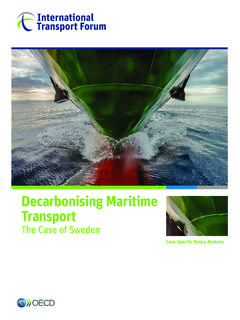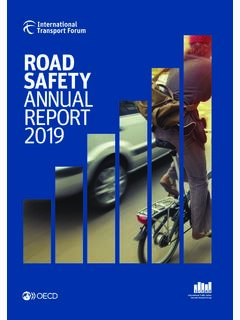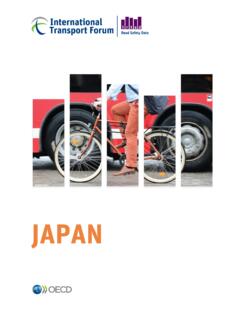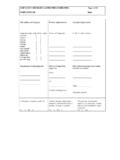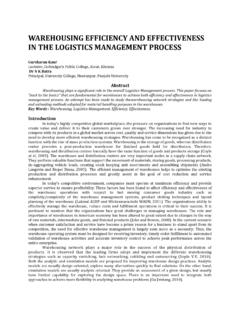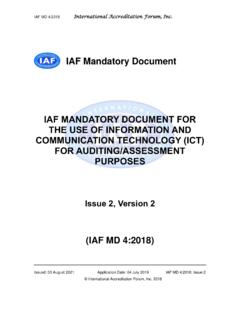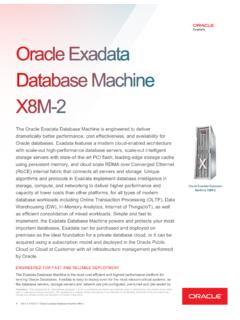Transcription of Performance measurement in freight transport
1 Performance measurement in freight transport : Its contribution to the design, implementation and monitoring of public policy Prepared for the Roundtable on Logistics Development Strategies and their Performance Measurements (9-10-March 2015, Queretaro) Alan MCKINNON Kuehne Logistics University, Hamburg, Germany February 20153 TABLE OF CONTENTS INTRODUCTION .. 5 1. freight transport INTENSITY: .. 72. freight MODAL SPLIT: .. Choice of metric .. 9 Directness of the routeing: .. 10 Intermodal freight movements: .. 10 Contestability of the freight market: .. 11 3. MARKET DIVERSITY: .. 114. OPERATIONAL efficiency .. Vehicle Loading .. 13 Fuel efficiency .. 17 5. SERVICE QUALITY:.. 176. ENVIRONMENTAL IMPACT: .. 197. CONCLUSION .. 20 REFERENCES .. 21 Performance measurement IN IN freight transport 5 INTRODUCTION freight transport is usually characterised as being the life-blood of a country and vital for its economic development, but political acknowledgement of its importance often does not extend as far as the statistics bureau.
2 As a result, little or no data gets collected to establish the nature and scale of the freight task and how it is changing. Evidence-based policy-making is clearly impossible within a statistical vacuum, leaving officials to rely on anecdotes, intuition and lessons learned from other countries. Regrettably, this is the situation in much of the developing world, where the macro-level study of freight transport has to start from a clean slate. At the other extreme are some developed countries with a long tradition of collecting freight data, where a range of parameters are carefully tracked on the basis of sample sizes that are large enough to make reasonably accurate assessments of patterns and trends. Even there, however, the statistical base is never complete. No country collects all the freight data that policy-makers and their analysts require to model, let alone understand, the detailed workings of the freight transport system.
3 With the advent of Big Data there will potentially be a step-change in the availability of freight data, allowing many of the existing gaps to be plugged and permitting the macro-level analysis of freight flows and operations at a higher degree of granularity. This remains to be seen. For many countries, the immediate objective is to collect enough freight data to answer four key public policy questions about freight transport : 1. How much freight is being moved? The amount of freight movement can be a good barometer of the level of economic activity. There has traditionally been a close correlation between freight tonne-kms and GDP, though the ratio of these variables can decline as an economy develops and services increase their share of total output. Knowing how much freight is being moved also indicates the related transport demands for infrastructural capacity, fuel, labour and vehicles. It can also shed light on the aggregate level of freight -related externalities.
4 2. Where is the freight going? Knowledge of the spatial pattern of freight flow is critical for infrastructure planning, the development of regional development strategies and the management of port and airport hinterlands. In an ideal world, statisticians would be able to track freight consignments across multi-link supply chains from initial origin to final destination, revealing the structure of logistics networks and product routing (McKinnon and Leonardi, 2009). Regrettably, the real world of freight statistics is a long way from this ideal. 3. What is the relative use of different transport modes? Few governments are satisfied with the existing freight modal split. Most aim to alter the allocation of freight between modes to relieve congestion on one or more infrastructures, reduce the Performance measurement IN IN freight transport 6 environmental impact of freight movement and / or correct what is deemed to be a market failure.
5 In the absence of freight data disaggregated by mode it is not possible to assess the scale of the problem and the potential for effecting a modal shift. 4. How efficiently is freight being transported? Where freight transport costs are higher as a result of inefficient operation, prices throughout the economy are inflated and business competitiveness impaired. Structural processes likely to promote economic development, such as the expansion of market areas and centralisation of production and inventory, are inhibited. Inefficient transport operations also tend to be more environmentally-damaging. So the level of efficiency needs to measured and the main causes of inefficiency identified and corrected. These are the basic questions that need to be answered to start the process of freight policy formulation. The paucity of freight data in many countries suggests that these questions are not even being asked.
6 As the NCFRP (2011: 38) observe, the lack of national freight system programs, Performance goals, or targets partially explains the lack of freight system Performance data . The early stages of policy-making must be underpinned by basic statistical knowledge of the freight transport system. One can get into a chicken and egg argument over the sequencing of data collection and strategy formulation thereafter. As policy evolves, as new objectives arise and as a broader range of policy instruments are deployed, causing the freight data requirements multiply. NCFRP (2011) suggest that one needs clarity regarding strategy and desired outcomes before going on to develop metrics to gauge the strategy s effectiveness . Figure 1 lists some of the main freight transport parameters that are often influenced by government intervention and gives of policy measures that affect them. Evidence-based decision-making on this range of interventions is inevitably very data hungry.
7 These data demands expand as freight policies are formulated at regional and urban levels by lower tiers of government. Normally regional and municipal authorities will be responsible for their own data collection though can benefit from the spatial disaggregation of national statistics where sample sizes are large enough. At all levels of freight policy-making, the main goal must be to improve the Performance of the freight transport system. The term Performance can be defined in different ways in this context. In this paper, we will examine six Performance criteria, all of which are inter-related 1. transport intensity 2. Modal split 3. Market diversity 4. Operational efficiency 5. Service quality 6. Environmental impact Performance measurement IN IN freight transport 7 Figure 1. Range of freight transport parameters influenced by government intervention Source: McKinnon, 2015a The paper will explain why these Performance criteria are significant and discuss the indices commonly used to use to measure them.
8 It will refer to freight policy and data issues in different parts of the world though many of the examples of good practice that it cites are drawn from Europe and North America. 1. freight transport INTENSITY This is usually defined as the ratio of freight tonne-kms to an economic output measure such as GDP. It is an important indicator of an economy s dependence on freight transport . Havenga and Simpson (2014) have shown that there are very wide international variations in the amount of GDP generated for each tonne-km of freight movement (Figure 1). For example, Norway earns approximately thirteen times more GDP per tonne-km than South Africa, mainly reflecting differences in the structure of these countries economies and the average value density ( $ per tonne) of the freight . Countries at an earlier stage in their development are usually more dependent on the production and export of low-value primary products that have to be moved in large quantities relative to national income.
9 As they develop, industrialisation, movement up the global value chain and growth of the service sector tend to depress the level of freight transport intensity. OECD / ITF (2015) indicate how freight intensity is a function of both per capita income in a country and the service sector share of GDP. It can also be affected by other factors, however, as illustrated by the diversity of freight intensity trends exhibited by EU member states, even between countries at similar levels of economic development and service penetration. Several studies have explored the observed decoupling of GDP and tonne-km trends in Performance measurement IN IN freight transport 8 countries such as the UK (McKinnon, 2005), Finland (Tapio, 2005) and the Spain (Alises et al, 2014). Figure 2. freight transport Intensity: amount of GDP generated per tonne-km Source: Havenga and Simpson, 2014 freight transport intensity is a Performance metric that few governments have tried to manipulate.
10 Broader economic policy affects the GDP denominator in the intensity ratio, but governments seldom try to influence total tonne-kms as an explicit policy objective. The exceptions are those countries for which logistics accounts for a large share of GDP. For example, the logistics and supply chain sector represented around 14% of the UEA s GDP in 2013 (Geronimo, 2014). Such global logistics hubs have a strong vested interest in maximising tonne-km throughput. At the other extreme, there have been a few examples of public policies designed to rationalise the pattern of freight movement and thereby reduce tonne-kms relative to economic activity mainly to ease environmental and congestion pressures. The Dutch government, for example, had a transport prevention scheme advising companies on ways economising on their use of freight transport , while within the EU s Marco Polo II programme companies could receive funding for transport avoidance actions.

